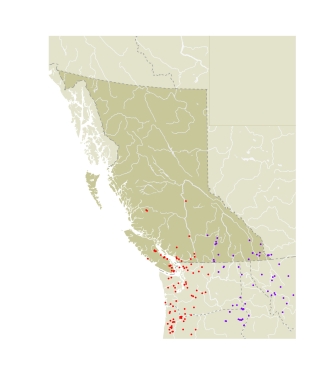AdultOreas Anglewings are similar to Zephyr Anglewings in the upperside of the wings. The hindwing margin has obvious patches of white fringe hairs, which are also present along the outer margin of the forewing. The basal half of the ventral wing surface is dark blackish grey, and the outer half is lighter in colour, similar to Grey Anglewings. Males and females are similar in coloration, although females tend to be larger and more brightly orange brown on the upperside.
Immature StagesMature larvae have black bodies, and the front edge of each segment has a dorsal line of pale yellow on the thorax and white on the abdomen. A more or less distinct pale yellow line runs down the middle of the back of the thorax (Edwards 1874-84). In contrast, mature larvae of subspecies areas from California are dark brown. The front half of the back is yellowish orange, with the middle area orangish yellow and the rear third pale yellowish. There are blackish "V" marks around the mid-dorsal spines of the rear half, with a larger brown mid-dorsal triangle within each "V" mark. There are black and cream rings around the body between segments, and a wavy orange line above the spiracles containing orange spines. The head is black with orange markings and two spiny black horns (Scott 1986b).
SubspeciesSubspecies silenus (W.H. Edwards, 1870) (TL: Portland, OR) is characterized by the extremely dark brown colour of the underside of the wings, which is unlike any other anglewing in BC. It occurs on Vancouver Island and the coastal mainland, north to Bella Coola on the coast and to Quesnel in the interior. From the Okanagan Valley east through the Kootenays to southeastern Alberta, and south through Washington, is an undescribed subspecies, for which we provide a name here.
Polygonia oreas threatfuli Guppy & Shepard, new subspecies. Polygonia oreas threatfuli is similar to subspecies silenus on the upperside. The upperside is much more darkly marked, and has smaller yellow submarginal spots on the dorsal hindwing, than nigrozephyrus Scott, 1984. On the underside of the wings, the basal half is dark blackish grey, and the outer half lighter grey. The overall ventral coloration is much lighter and greyer than that of subspecies silenus, and the reddish edge to the wings of silenus is absent from threatfuli. The ventral wings are darker, and grey rather than brown, compared with those of the nominate subspecies. The wing margin is less strongly scalloped than in silenus, similar to that of nigrozephyrus, and slightly less scalloped than that of the nominate subspecies. Types. Holotype: female, BC, Vernon, Kalamalka L. Prov. Park, 21 September 1982, D.L. Threatful; a label "HOLOTYPE / Polygonia oreas / threatfuli Guppy & Shepard" is attached. The holotype is deposited in the Royal British Columbia Museum, Victoria, BC, CAN. Paratypes: 1 female, BC, Enderby, 7 Sep 1921, J. Wynne (UBC); 1 female, BC, Enderby, 20 Aug 1921, J. Wynne (UBC); 3 males, BC, Enderby, 4 Sep 1921, J. Wynne (UBC); 1 male, 1 female, BC, W. Crescent Valley, 23 May 1967, J.H. Shepard (JHS); 1 female, BC, W. Crescent Valley, 5 June 1967, J.H. Shepard (JHS); 1 male, BC, Natal, 18 mi. W, 17 June 1968, J.H. Shepard (JHS); 1 male, BC, near Yahk, 3 mi. W. junction Hwy 3/95, 16 June 1967, J.H. Shepard (JHS).
